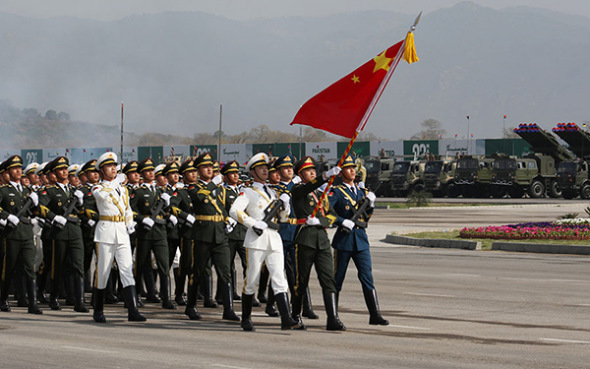
The People's Liberation Army Honor Guards take part in a rehearsal for the annual Pakistan Day parade in Islamabad, on March 19, 2017. (Photo by Wang Qi/For China Daily)
The ongoing China Central TV documentary Carrying the Reform Through to the End emphasizes the importance of a strong military to realize the Chinese Dream. China needs to synchronize its military strength with its economic and social development to better protect its national interests.
And as President Xi Jinping, also chairman of the Central Military Commission, has reiterated, it is important to modernize the military along with its weapons and equipment, and the technologies it uses to better safeguard the sovereignty and integrity of China.
In the 90 years since its establishment on Aug 1, 1927, the People's Liberation Army has evolved significantly and rapidly, particularly when it comes to the defense technologies and the weapons it uses.
Heavy weapons were a luxury to the PLA, whose capability of producing ammunition and repairing sophisticated equipment was limited before the founding of the People's Republic of China in 1949. Most of the weapons the PLA used were, in fact, seized from the enemies.
But between 1950 and 1978 China managed to rid itself of the reliance on imported weapons. Major imports from the Soviet Union, including MiG-15 aircraft and T-54 tanks, allowed China to develop what were then cutting-edge weapons on its own. China's J-5 fighter jets and Type-59 battle tanks, for example, drew inspiration from the MiG-15 warplanes and T-54 tanks. By 1959, China also managed to make artillery equipment domestically. These gradual developments were in line with the economic recovery and the industrial buildup of New China.
The development of the atomic bomb and missiles was another landmark for China, especially because the Soviet Union had withdrawn its technological aid to China in 1962. In the following two decades, Beijing shifted its focus from emulating advanced weapons to developing them independently.
The first atomic bomb test at the Lop Nur nuclear test site in Northwest China's Xinjiang Uygur autonomous region in 1964 made China the fifth nuclear power. The "Two Bombs, One Satellite" project, which included atomic and hydrogen bombs and artificial satellite, cost China about 10 billion yuan, 2 percent of its annual expenditure and 12 percent of its defense expenditure then.


















































